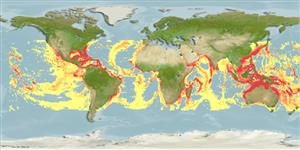Ikan bertulang rawan (sharks and rays) >
Carcharhiniformes (Ground sharks) >
Carcharhinidae (Requiem sharks)
Etymology: Carcharhinus: Greek, karcharos = sharpen + Greek, rhinos = nose (Ref. 45335).
Lingkungan / Klimat / Range
Ekologi
; laut berasosiasi dengan karang; oceanodromus (Ref. 51243); kisaran kedalaman 0 - 4000 m (Ref. 55180), usually 0 - 500 m (Ref. 6871). Subtropical; 23°C - 24°C (Ref. 244), preferred 27°C (Ref. 107945); 42°N - 43°S, 169°W - 180°E (Ref. 55180)
Circumtropical. Western Atlantic: Massachusetts, USA to southern Brazil, including the Gulf of Mexico and the Caribbean Sea to Uruguay (Ref. 58839). Eastern Atlantic: Spain, Madeira to northern Angola; St. Paul's Rocks (Ref. 13121); Cape Verde (Ref. 34514). Indo-Pacific: scattered records from the Red Sea and Natal, South Africa (Ref. 5578) to China, New Zealand, and the Caroline, Hawaiian, Phoenix and Line islands. Eastern Pacific: southern Baja California, Mexico to northern Chile. Highly migratory species, Annex I of the 1982 Convention on the Law of the Sea (Ref. 26139).
Length at first maturity / Size / Weight / umur
Maturity: Lm 228.0, range 202 - 260 cm
Max length : 350 cm TL jantan/; (Ref. 9997); common length : 250 cm TL jantan/; (Ref. 9997); Berat maksimum terpublikasi: 346.0 kg (Ref. 40637); Umur maksimum dilaporkan: 25 Tahun (Ref. 31395)
Duri punggung (Keseluruhan (total)): 0; duri punggung lunak (Keseluruhan (total)): 0; Duri dubur 0; Sirip dubur lunak: 0. A large, slim shark with a moderately long, flat and rounded snout, large eyes, small jaws, and oblique-cusped teeth with serrations; 2nd dorsal fin low and with greatly elongated rear tip (Ref. 5578). Grey or bluish-grey above, white below; no conspicuous fin markings (Ref. 5578). Only Carcharhinus species with an interdorsal ridge that has the dorsal fin origin behind the free rear tip of the pectoral fin (Ref. 26938).
Found abundantly near the edge of continental and insular shelves, but also in the open sea and occasionally inshore (Ref. 244). Often found in deepwater reefs and near insular slopes (Ref. 244). Littoral and epipelagic, in the open sea or near the bottom at 18-500 m (Ref. 58302). It is quick-moving and aggressive (Ref. 244). Solitary (Ref. 26340); often associated with schools of tuna (Ref. 244). Feeds mainly on fishes, but also squid, paper nautiluses, and pelagic crabs (Ref. 244; 37816). Viviparous (Ref. 50449). Regarded as dangerous to humans (Ref. 9997). Flesh utilized fresh and dried-salted for human consumption; its hide for leather; its fin for shark-fin soup; its liver for oil (Ref. 244). 2 to 14 young, 73 to 87 cm, are born per litter (Ref. 1602).
Viviparous, placental (Ref. 50449). 2-15 pups (Ref. 6871, 37816) born at 57-87 cm TL (Ref. 9997); 1-16 pups born at 55-72 cm TL. Females appear to breed every year, but there appears to be no reproductive seasonality (Ref.58048). Distinct pairing with embrace (Ref. 205).
Compagno, L.J.V., 1984. FAO Species Catalogue. Vol. 4. Sharks of the world. An annotated and illustrated catalogue of shark species known to date. Part 2 - Carcharhiniformes. FAO Fish. Synop. 125(4/2):251-655. Rome: FAO. (Ref. 244)
Status IUCN Red List (Ref. 115185)
CITES (Ref. 94142)
Not Evaluated
ancaman kepada manusia
Traumatogenic (Ref. 9997)
penggunaan manusia
Perikanan: bernilai komersial tinggi
informasi lanjut
AcuanBudidaya airprofil budidaya airStrainGenetikaFrekuensi alelDiturunkanPenyakit-penyakitPengolahanMass conversion
mitraGambarStamps, CoinsSuara-suaraCiguateraKecepatanTipe renangArea insangOtolithsOtakPenglihatan / visi
Alat, peralatan
laporan khas
muat turun XML
Sumber internet
